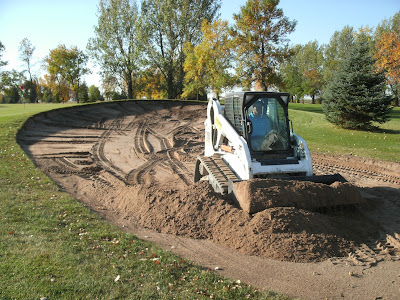 |
| These cores were pulled from the blue tee on 17 back in July. I realized at this point that aeration and topdressing would be a 10 year process to get rid of this much thatch. |
After approaching the board this fall with the idea of starting the process of rebuilding some tees, the decision was made to try one or two this year to see how it goes. I made the decision to start with #5 since it is a par 3 and tends to get hammered with divots. Our new tees will be much firmer thus producing smaller divots that will also heal in much faster since the crown of the turf plant may be left intact in some cases.
We tore into hole 5 tee last week, the first part of the process was to completely remove the old tee surface and all the thatch so we could start over with a new rootzone. A tracked skid loader was used to scrape off the surface and then haul it off. I was absolutely amazed throughout the removal process of just how thick the thatch was in spots.
 |
| Beginning of the surface removal process on hole 5 |
 |
| Close up of thatch depth, that's the soft junk that was allowing such massive divots to come off the par 3 tees. |
 |
| Every superintendent's dream: doing donuts on his own course before tearing it up for renovation! |
The next step would be to set the forms around the edge of the tee to place our new rootzone inside of and get the tee perfectly level. After a discussion with some USGA folks and an agronomist, and sending in a sample of our bunker sand to a lab for analysis, the decision was made to utilize our old bunker sand as our new rootzone for the tees. Doing this will allow us to kill the proverbial 'one bird with two stones'. Not only will we be getting a better medium to grow quality bentgrass on for the tees, but we will then be able to put fresh sand in a lot of our bunkers, which is also something that was drastically needed. Essentially we are only having to buy sand once instead of twice.
 |
| Forms set on 5 for the new tee rootzone. This process was shot with a transit level to ensure a perfectly flat surface. |
 |
| Removing old bunker sand by 5 green. The sand depth after years of mechanical raking was spread around between 1" and 12". |
 |
| Spreading new rootzone sand on hole 5. |
 |
| Our assistant superintenent, Andy Hokanson, discing in a soil amendement into the sand rootzone. This will give the sand much better water and nutrient holding capacities. |
The new tee surface was then spread around perfectly level (although a 1% pitch was provided to one side to allow for surface drainage, but I challange anyone to tell me which way that tee is pitched when you play off of it.) After a good final grade raking, the entire area was fertilized with two products and then seeded in two directions. A bluegrass/ryegrass blend was seeded on the outsides of the tee, while Penncross creeping bentgrass was seeded for the actual tee surface. While all of these tees that we seed this fall will germinate and start to grow a little bit, I anticipate that it will not be until early next June 2012 that we will be able to play off of them. Keep your fingers crossed for a nice, sunny spring!
 |
| Finished product on hole 5 |
Thus far the new tee on hole 5 and 12 have been completed and seeded. Hole 12 tee was moved over to the right about five feet to allow for better line of sight past the trees on the left side of the hole, and a new cartpath will be added along the left edge of the tee for better access. New red tee boxes on holes 2, 4, 7, 11, and 13 were also built this fall. These par 4's were in desperate need of giving some of the ladies a little more advantage. Furthermore, that will allow for more room for the remaining three tees (particularly the whites) to be moved around a little more on the rest of the tee surface.
I will continue to update on here with the condition of the new tees as they grow in. In the meantime, please be extra considerate of our temporary tees by filling all your divots on them!


No comments:
Post a Comment